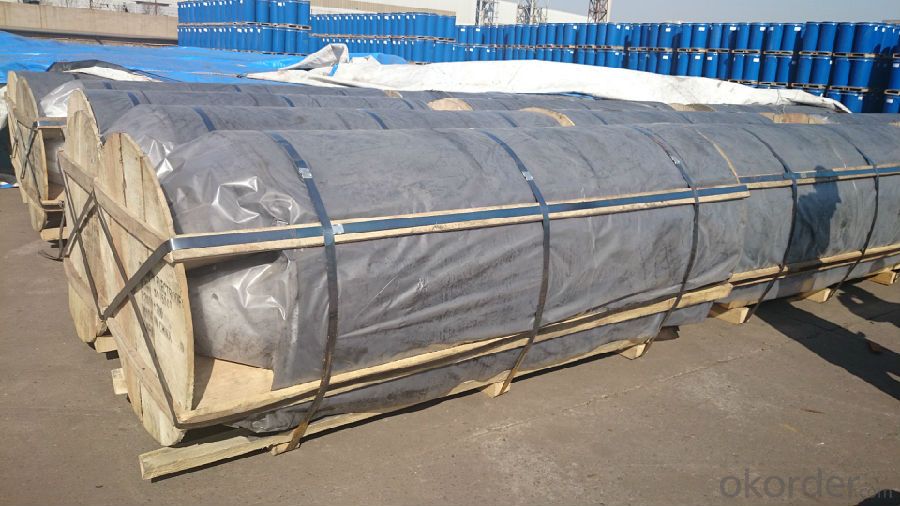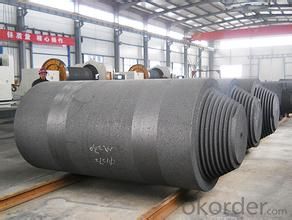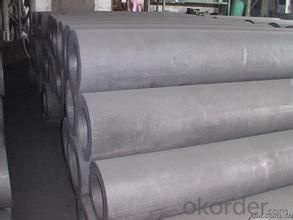Carbon Electrodes with Diameter Φ500 to Φ700
- Loading Port:
- Lianyungang
- Payment Terms:
- TT OR LC
- Min Order Qty:
- 20 m.t.
- Supply Capability:
- 700 m.t./month
OKorder Service Pledge
OKorder Financial Service
You Might Also Like
Spcifications
1:carbon eletrode
2:for ferroalloy,calcium carbide, silicon metal, manufacture
Product Description
Carbon Electrode is abaked electrode used in submerged arc furnaces for delivering power to the charge mix. Electrode is added to the top of the electrode column cylindrical form. Electrode is essentially a mix of Electrically Calcined Anthracite (ECA) or Calcined Petroleum Coke (CPC) with Coal Tar Pitch and is baked for weeks, it is widly used for ferroally productiong, silicon metal production etc.
Graphite/Carbon Electrode Paste Specification:
| PARAMETER UNIT GUARANTEE VALUE | ||||||
| Items | Φ500~Φ700 | Φ750~Φ960 | Φ1020~Φ1400 | |||
| Rs μΩ.m | ≤45 | ≤38 | ≤45 | ≤38 | ≤40 | |
| Bulk Desity g/cm3 | ≥1.55 | ≥1.58 | ≥1.55 | ≥1.58 | ≥1.55 | ≥1.58 |
| Bending Strength MPa | 3.5~7.5 | 4.0~7.5 | 3.5~7.5 | 4.0~7.5 | 3.5~7.5 | 4.0~7.5 |
| Compressive Strength MPa | ≥20.0 | ≥20.0 | ≥20.0 | ≥20.0 | ≥19.0 | ≥19.0 |
| Compressive Strength MPa | 3.2~4.8 | 3.0~4.6 | 3.2~4.8 | 3.0~4.6 | 3.2~4.8 | 3.0~4.6 |
| Ash % | ≤2.5 | ≤2.0 | ≤2.5 | ≤2.0 | ≤2.5 | ≤2.0 |
Picture:




We can adjust the size based on different enquiry. please contact us if you are interested in this materials, we will send our offer as soon as get your kind email.
Do you know how many kinds of our graphite electrode?
1, according to the power, we have regular power, high power, super high power, super high power
and American Ucar standard.
2, according to the shape, we have round shape and square shape.
3, according to the size, the diameter is from 250mm to 700mm.
- Q:What is the role of carbon in the formation of coal, oil, and natural gas?
- Carbon plays a crucial role in the formation of coal, oil, and natural gas. These fossil fuels are primarily composed of carbon, along with varying amounts of hydrogen, sulfur, nitrogen, and other elements. The formation of these fuels begins with the accumulation of organic matter, such as dead plants and marine organisms, in environments with limited oxygen. Over millions of years, the organic matter is subjected to intense heat and pressure, causing a process known as carbonization. During carbonization, the carbon in the organic matter undergoes chemical changes, transforming it into solid, liquid, or gaseous hydrocarbon compounds. The specific conditions under which carbonization occurs determine the type of fossil fuel that will be formed. In the case of coal, the organic matter is primarily land-based plant material. Under high pressure and temperature, carbonization converts this plant material into solid coal. The longer and more intense the carbonization process, the higher the carbon content in the resulting coal. Different types of coal, such as lignite, bituminous, and anthracite, have varying carbon content and energy density. Oil, on the other hand, is formed from marine organisms like plankton and algae. As these organisms die, they sink to the bottom of oceans or lakes and are gradually buried under sediment layers. Over time, the heat and pressure cause carbonization, transforming the organic matter into a liquid hydrocarbon mixture known as crude oil. This oil can then be further processed into various petroleum products. Natural gas is primarily composed of methane (CH4) and is formed in similar conditions as oil. However, the carbonization process occurs at higher temperatures and pressures, causing the organic matter to break down into gaseous hydrocarbon compounds. Natural gas can be found alongside oil deposits or trapped in underground rock formations, such as shale or sandstone. Therefore, carbon is the fundamental building block of coal, oil, and natural gas. Its presence in organic matter, combined with the right conditions of heat, pressure, and time, leads to the formation of these valuable energy resources that play a significant role in powering our modern world.
- Q:What is carbon black used for?
- Carbon black is a versatile substance that finds applications in various industries. Primarily, it is used as a pigment and reinforcing filler in the production of rubber products, such as tires, hoses, and belts. The addition of carbon black enhances the strength, durability, and resistance to abrasion of rubber materials. Additionally, carbon black is used as a coloring agent in inks, paints, and coatings due to its excellent light-absorbing properties. It provides intense black color and improves the UV resistance of these products. Moreover, carbon black is utilized in the production of plastics, where it acts as a filler to enhance the mechanical properties of plastic components and reduce their cost. In the energy sector, carbon black is employed as a conductive additive in batteries and fuel cells. Its high electrical conductivity enhances the performance of these energy storage devices. Carbon black is also used in the manufacture of electrodes for supercapacitors, where its large surface area enables efficient energy storage. Furthermore, carbon black has applications in the construction industry as a reinforcing agent in concrete and asphalt. It enhances the strength and durability of these materials, making them more resistant to cracking and weathering. In summary, carbon black is widely used in the production of rubber, plastics, inks, paints, coatings, batteries, fuel cells, supercapacitors, and construction materials. Its properties as a pigment, reinforcing filler, coloring agent, and conductive additive make it a valuable material in numerous industrial applications.
- Q:What is the thickness of carbon fiber heating?
- The hair line is 4-5mm, and here is the 2CM thermal insulation board. It's only 2.4,2.5 of the total. You can go to Ji'nan emperor long carbon fiber to see, they have a full product and reliable quality.Please accept the answer and support me.
- Q:What are the industrial uses of diamonds?
- Diamonds have a wide range of industrial uses due to their exceptional physical properties. One of the most common industrial uses of diamonds is in the manufacturing of cutting and grinding tools. Diamond-tipped saw blades, drill bits, and grinding wheels are highly sought after for their superior hardness and abrasion resistance. These tools are used to cut and shape hard materials like concrete, ceramics, and metals. Diamonds also find extensive applications in the electronics industry. They are used as heat sinks in high-power electronic devices and as abrasive materials for polishing and lapping electronic components. The thermal conductivity of diamonds allows them to efficiently dissipate heat, making them ideal for electronic devices that generate a lot of heat during operation. Furthermore, diamonds are used in the production of specialized windows, lenses, and prisms for various scientific and industrial applications. Their optical properties, such as high refractive index and low dispersion, make them valuable for creating precision optics used in lasers, spectroscopy, and telecommunications. In addition, diamonds have found niche uses in the medical and dental fields. They are used in surgical tools such as scalpels and dental drills due to their exceptional hardness and ability to retain sharp edges. Diamond coatings are also applied to medical implants and prosthetics to improve their wear resistance and biocompatibility. Lastly, diamonds are utilized in the oil and gas industry for drilling and exploration purposes. Diamond drill bits are capable of penetrating extremely hard rock formations, making them essential for extracting oil and natural gas from deep beneath the Earth's surface. Overall, the industrial uses of diamonds are vast and diverse, ranging from cutting and grinding tools to electronics, optics, medicine, and even oil and gas exploration. The unique properties of diamonds make them indispensable in numerous industrial applications, contributing to advancements in various fields.
- Q:I want to make a rectangular round bar for bearing. What carbon fiber and carbon fiber should be used? How should I do it? What kind of machine does it use to dry it?
- Carbon fiber is not plastic, and plastic is not the same material. Carbon fiber forming process is mainly:A molding process is: by hand will prepreg paper in the mold, and then curing. This is the biggest advantage of simple manufacturing process, manual to complete more complex operations, can process the complex shape parts, suitable for small batch production; the disadvantage is low efficiency and poor labor conditions, labor intensity is big.Filament winding forming technology: the earliest continuous forming process, that is, the fiber is dipped into the resin through the resin trough, and then wrapped on the rotating core mold according to certain rules. Then, the glue is solidified and formed by heating. A prominent feature is that it is in accordance with the stress situation of products, the fiber according to a certain rule arrangement, so as to give full play to the strength of the fiber, obtain the lightweight products; can realize continuous and mechanized production in the process, and short production cycle, high production efficiency, low labor intensity, suitable for manufacturing cylinder the sphere, and some positive curvature gyration bodies or tubular products.
- Q:How does carbon impact the prevalence of wildfires?
- Carbon impacts the prevalence of wildfires in several ways. First, carbon dioxide (CO2) is a greenhouse gas that contributes to climate change. As concentrations of CO2 increase in the atmosphere, temperatures rise, leading to drier conditions in many regions. These dry conditions create a more favorable environment for wildfires to ignite and spread. Furthermore, carbon plays a significant role in the fuel load that can feed wildfires. Carbon-based materials, such as dead vegetation, trees, and other organic matter, serve as the primary fuel source for fires. As carbon accumulates in ecosystems, either through natural processes or human activities like deforestation, the amount of potential fuel for wildfires increases. This elevated fuel load can result in more frequent and intense fires. Additionally, carbon impacts the health and vitality of forests. Elevated levels of atmospheric CO2 can enhance plant growth, leading to denser vegetation. While this may seem beneficial, it can actually contribute to the intensity and severity of wildfires. Denser vegetation creates a greater amount of fuel, and when combined with the dry conditions caused by climate change, it becomes a recipe for more destructive fires. Lastly, the combustion of carbon-based materials during wildfires releases large amounts of carbon dioxide into the atmosphere. This creates a positive feedback loop, as the increased carbon emissions contribute to further climate change, which in turn exacerbates the conditions for wildfires. Overall, carbon plays a crucial role in shaping the prevalence and severity of wildfires through its impact on climate change, fuel load, forest health, and the release of greenhouse gases during combustion. Addressing carbon emissions and implementing effective forest management practices are essential in mitigating the risks and impacts associated with wildfires.
- Q:How can I see if a battery can be used to recharge it?Can not all carbon batteries charge?
- Final conclusion:Carbon batteries, alkaline batteries are not charged, the voltage is 1.5V, nickel cadmium batteries, nickel hydrogen batteries can charge voltage 1.2VPay special attention to the risk of leakage or explosion if you charge to a carbon battery or alkaline battery
- Q:How does carbon impact the acidity of rainfall?
- The acidity of rainfall is influenced by carbon, which causes acid rain. Acid rain is formed when carbon dioxide (CO2) is released into the atmosphere and combines with water (H2O) to create carbonic acid (H2CO3). This natural reaction has been significantly amplified by human activities like burning fossil fuels and industrial processes, resulting in increased levels of carbon dioxide in the atmosphere. Once carbonic acid is formed, it can further react with other compounds in the air, such as sulfur dioxide (SO2) and nitrogen oxides (NOx), leading to the formation of stronger acids like sulfuric acid (H2SO4) and nitric acid (HNO3). These acids then dissolve in rainwater and produce acid rain. The presence of carbon in the atmosphere contributes to the overall acidity of rainfall. Acid rain has harmful effects on the environment, ecosystems, and human health. It causes damage to forests, lakes, and rivers, leading to the decline of fish populations and destruction of habitats. Additionally, acid rain corrodes buildings and monuments, erodes metals, and harms crops. The impact of carbon on the acidity of rainfall emphasizes the significance of reducing carbon emissions and addressing climate change. By transitioning to cleaner energy sources, implementing sustainable practices, and reducing our carbon footprint, we can help mitigate the acidity of rainfall and minimize the negative consequences associated with acid rain.
- Q:What are the consequences of increased carbon emissions on coral reefs?
- The consequences of increased carbon emissions on coral reefs are highly detrimental. Elevated carbon dioxide levels in the atmosphere lead to ocean acidification, which negatively impacts the ability of corals to build their calcium carbonate skeletons. This results in weakened and brittle coral structures, making them more susceptible to damage from storms and other environmental stressors. Additionally, higher temperatures caused by carbon emissions contribute to coral bleaching events, where corals expel the symbiotic algae that provide them with essential nutrients and vibrant colors. These combined effects of ocean acidification and warming ultimately lead to significant coral reef degradation, loss of biodiversity, and the decline of ecosystem services provided by these valuable marine habitats.
- Q:How does carbon affect water quality?
- Water quality can be affected both positively and negatively by carbon. On the positive side, carbon is a natural component of the carbon cycle and has a vital role in maintaining the equilibrium of aquatic ecosystems. It serves as a nutrient for aquatic plants, aiding their growth and providing nourishment and shelter for other organisms in the food chain. However, an excess of carbon in water can have adverse effects on water quality. One way this occurs is through the rise of dissolved organic carbon (DOC). Elevated levels of DOC can result from the decomposition of organic matter, such as deceased plants and animals, as well as the leaching of organic compounds from soil. These organic compounds can harm water quality by diminishing the amount of dissolved oxygen accessible to aquatic organisms, leading to asphyxiation of fish and other aquatic life. Moreover, high levels of carbon can contribute to eutrophication. Eutrophication takes place when there is an overflow of nutrients, including carbon, in water bodies, causing an excessive growth of algae and other aquatic plants. This excessive growth can deplete oxygen levels in the water as the plants decompose, causing harm to fish and other organisms that rely on oxygen for survival. Additionally, carbon can interact with other pollutants present in water, like heavy metals and pesticides, which can become more toxic and readily available when combined with carbon. This can have detrimental effects on aquatic organisms and disrupt the overall balance of the ecosystem. In conclusion, while carbon is vital for the functioning of aquatic ecosystems, excessive amounts can negatively impact water quality by reducing oxygen levels, promoting eutrophication, and increasing the toxicity of other pollutants. Therefore, it is crucial to monitor and manage carbon levels in water bodies to ensure the maintenance of a healthy and balanced aquatic ecosystem.
1. Manufacturer Overview |
|
|---|---|
| Location | |
| Year Established | |
| Annual Output Value | |
| Main Markets | |
| Company Certifications | |
2. Manufacturer Certificates |
|
|---|---|
| a) Certification Name | |
| Range | |
| Reference | |
| Validity Period | |
3. Manufacturer Capability |
|
|---|---|
| a)Trade Capacity | |
| Nearest Port | |
| Export Percentage | |
| No.of Employees in Trade Department | |
| Language Spoken: | |
| b)Factory Information | |
| Factory Size: | |
| No. of Production Lines | |
| Contract Manufacturing | |
| Product Price Range | |
Send your message to us
Carbon Electrodes with Diameter Φ500 to Φ700
- Loading Port:
- Lianyungang
- Payment Terms:
- TT OR LC
- Min Order Qty:
- 20 m.t.
- Supply Capability:
- 700 m.t./month
OKorder Service Pledge
OKorder Financial Service
Similar products
New products
Hot products






























